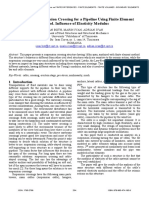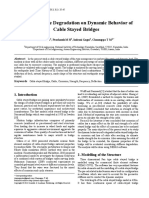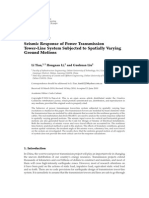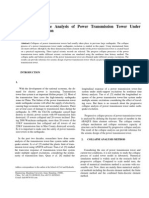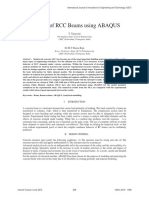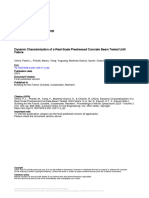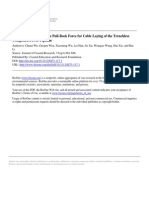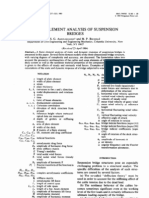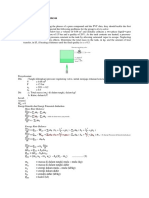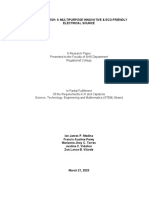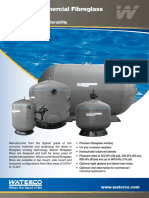Numerical Simulations of A Pipeline Crossing: Abstract - The Paper Presents The Application of Computer
Numerical Simulations of A Pipeline Crossing: Abstract - The Paper Presents The Application of Computer
Uploaded by
Umar KidaCopyright:
Available Formats
Numerical Simulations of A Pipeline Crossing: Abstract - The Paper Presents The Application of Computer
Numerical Simulations of A Pipeline Crossing: Abstract - The Paper Presents The Application of Computer
Uploaded by
Umar KidaOriginal Description:
Original Title
Copyright
Available Formats
Share this document
Did you find this document useful?
Is this content inappropriate?
Copyright:
Available Formats
Numerical Simulations of A Pipeline Crossing: Abstract - The Paper Presents The Application of Computer
Numerical Simulations of A Pipeline Crossing: Abstract - The Paper Presents The Application of Computer
Uploaded by
Umar KidaCopyright:
Available Formats
New Developments in Computational Intelligence and Computer Science
Numerical simulations of a pipeline crossing
Ioan Both, Adrian Ivan
crossing, cable-stayed crossing, self-supporting or truss
structure as a bearing structural system for the pipeline. The
span that needs to be covered by the crossing is the main
factor that influences this decision. Two reasonable solutions
are suspension crossing and cable-stayed crossing. The last
one has the advantage of smaller anchors and possibility of
building on soft soil, but if the span increases the towers will
have to increase too much [2]. To overcome this disadvantage
the appropriate solution are suspension crossings.
Towers, main cables (suspension cable), hangers, anchors,
lateral cables, cantilever (not necessary) and the pipeline are
components of the structural system of a suspension crossing.
The load path for these structures is created as follows: the
gravitational loadings from the self-weight and the loading
given by the gas in the pipe is transmitted by the hangers to
the main cable. The hangers have various lengths
corresponding to the sag of the main cable. The main cables
transmit a part of the vertical component of the force in the
cable to the towers and the horizontal component is
transmitted to the anchors. The horizontal actions,
perpendicular to the crossing, are taken by the lateral cables
(wind guy cable), connected to the pipeline by the wind ties
[3].
The cable elements in these structures have an important
role and it is characterized by high resistance, high flexibility,
and a very small damping. Due to large displacements,
suspension crossings design should consider both static and
dynamic analysis.
Numerous methods of crossing erection are available in
practice and the decision for the solution is taken upon the
security and economic aspects. The forces in the cable
elements and bending moment in the pipeline are dependent
on the steps of structure assembling and a construction stage
analysis may reveal critical stages of force development.
Results of numerical simulations for a suspension crossing
with the span of 160m considering static and dynamic actions
are presented within the contents of this paper. The numerical
model was defined by means of members: cables were
modeled as cable elements taking into account initial stress,
2nd order geometrical nonlinearity and beam local
nonlinearity, towers elements and the pipe was modeled
using linear bar elements.
The paper will give the results of the analysis of the same
structure taking into consideration different masses for modal
analysis. A real wind velocity-time variation as recorded on
site is used for establishing the dynamic response of the
structure to wind action. Also a simulation on the staged
construction for the suspension crossing is performed.
Abstract The paper presents the application of computer
codes in the advanced analysis of structures with tension
elements, cables. Static and dynamic analyses are performed
for a suspension pipeline crossing by considering a real wind
intensity recorded by a weather station. The effect of pretension is discussed from the structure Eigen-modes aspect.
The static and dynamic analysis reveals different values for
element forces. A construction stage analysis is performed
using a particular module of finite element computer code
Keywords cable, construction stage, dynamic analysis,
suspension crossing.
I. INTRODUCTION
TRUCTURAL
systems supporting fluid materials
transportation pipelines may be regarded as a continuous
structure avoiding encountered obstacles between the two
points of interest. The linear impediments such as rivers or
valleys met in their path may be overcome with
superstructures (above) or infrastructures (below). For both
solutions advantages and disadvantages are present and for a
good design the important factor is the area environment
either from geometry, sustainability or protection point of
view. The waterway crossing is an example that the choice of
solution is influenced by several considerations. One of them
refers to the environment impact. The disturbance of
environment for both aquatic and terrestrial plant and animal
life has to be minimized since a waterway crossing affects
these factors. Both crossings, under and above water, have to
take care at the hazardous and contaminated materials during
construction [1]. The underwater crossing might have a
greater effect over the environment because of the instability
of the river bed and from here a catastrophic event is possible
to occur. Waterways constructed above obstacles have the
advantage that it allows better site inspections and most of the
loading can be easily determined. Having a decision for a
structural system over the obstacle it only remains to decide
which solution of the structure is better to use: suspension
This publication was supported by the European social fund within the
framework of realizing the project Support of inter-sectoral mobility and
quality enhancement of research teams at Czech Technical University in
Prague, CZ.1.07/2.3.00/30.0034.
I. Both is with the Czech Technical University in Prague, Prague, 16629
Czech Republic (corresponding author, phone: 0040-727882621; e-mail:
ioan.both@ct.upt.ro).
A. Ivan is with the Politehnnica University of Timisoara, Timisoara,
Timisoara, 300006 Romania (e-mail: adrian.ivan@upt.ro).
ISBN: 978-1-61804-286-6
45
New Developments in Computational Intelligence and Computer Science
wind - 0.46kN/m,
pretension - variable.
All supports were considered to follow the restrictions only
for translational degrees of freedom and the elements of the
II. CASE STUDY
The structure analyzed in this paper represents a crossing
with a span of 160m and two adjacent spans of 35m, an initial
deflection of suspension cable of 12.5m leading to a value of
12.8 for the span to cable sag ratio. The vertical hangers are
positioned at each 5m and the pipeline has a circular hollow
section with a diameter of 700mm and a thickness of 8mm.
Fig. 2 Wind recording station VS425
tower were also considered to be hinges.
For a dynamic analysis a load case defined function of the
recordings of the wind action was considered. The values of
Fig. 1 Model of the case study
There are two main cables in the vertical planes situated at 2m
and two inclined cables for lateral load and vertical
stabilization. Two towers are placed at the end of the pipeline
consisting of hot-rolled profiles HEB400 as vertical elements
and square hollow sections 150/4 as bracings. The hangers
and the wind ties have a diameter of 40mm whereas the main
cables and the lateral cables have a diameter of 60mm (Fig. 1).
Such structures are highly complex since flexible support
system may be attributed to the structure and for each element
the boundary conditions are determined and influenced by the
characteristics of the linked element [4]. Due to length
variation each node of the main cable will have different
interactions for the boundary conditions.
The cross section and material properties of the crossing are
presented in Table I, where: M-main, L-lateral, T-torsional
moment of inertia, E-modulus of elasticity, A-area of the
cross-section, Ix-moment of inertia with respect to x axis, Iymoment of inertia with respect to y axis. The properties of the
tower are given for the entire truss structure.
Table I
Element
E
A
T
Ix
Iy
[N/mm2] [mm2] [mm4]
[mm4]
[mm4]
M cable
1.5-2e5
2827
0
0
0
L cable
1.5-2e5
2827
0
0
0
Hangers 1.5-2e5
1194
0
0
0
Windguy 1.5-2e5
1194
0
0
0
Tower
2.1e5
46.6e3 3.17e5 4.7e10
1.2e9
Pipe
2.1e5
17.4e3 2.8e9 1.04e9
1.04e9
In the analysis of the structure the following values of
loading were considered:
self-weight program computed,
permanent load - 0.7kN/m,
imposed load from fluid - 3.675kN/m,
ISBN: 978-1-61804-286-6
Fig. 3 Wind velocity
the wind velocities were provided by the local weather station
for the west region of Romania monitored by an automatic
station with ultrasonic transducer VS425 (Fig. 2) on the
Mures river in Arad county, Varadia area. The maximum
values recorded since the weather station was installed, 2009,
are depicted in Fig.3.
III. LIMIT STATE ANALYSIS OF STRUCTURE
The forces and moments in the structural elements were
determined using the FEM computer code SAP2000 for both
static and dynamic analysis.
Damping ratios of such tension bar systems are particular
due to their range interval as shown in [5]. It is common to use
for a dynamic analysis proportional damping values from 0.04
to 0.1.
A certain level of pretension force is introduced in the
cables of the structure in order to obtain the desired geometry
in the final stage of construction. The Eigen modes of the
Due to the difference of 1.6s between the two cases of
considered structural mass the resulting forces may vary
46
New Developments in Computational Intelligence and Computer Science
significantly. The behavior of structure taking into
consideration the equivalent mass of self-weight is shown in
Fig. 4 and Fig. 5
Fig. 4 shows the displacement of pipeline nodes in the
horizontal plane for the dynamic analysis of wind action,
applying the modal matrix for the pretensioned state of
structure.
Fig. 5 shows the displacement of pipeline nodes in the
horizontal plane for the dynamic analysis of wind action,
applying the modal matrix for the pretension state of structure.
Fig. 7 shows the displacement of pipeline nodes in the
horizontal plane for the dynamic analysis of wind action,
applying the modal matrix for the pretension and filled pipe,
state of structure.
It can be seen that the maximum deflection of central node,
when the mass is taken only the self-weight, is larger than the
Fig. 6 Deflection - pretensioned state of structure (mperm+cvp)
Fig. 4 Deflection - pretensioned state of structure (mperm)
Fig. 7 Deflection - loaded state of structure (mperm+cvp)
deflection in the case of equivalent mass from loaded pipeline,
200mm (Fig. 4) and 145mm (Fig. 6).
Not every node of the pipeline is following the sinusoidal
path but their period (frequency) is the same for each node,
therefore the first Eigen mode is relevant for analysis.
Table III Forces in the elements of the structure
Fig. 5 Deflection - loaded state of structure (mperm)
applying the modal matrix for the pretensioned and filled pipe,
state of structure.
The curve following the maximum values in the chart of
Fig. 4 Fig. 7 represent the midspan of the crossing whereas
the intermediate curves represent nodes between midspan and
towers.
Table II
mperm
Mode
1
2
3
4
5
6
T [s]
(Kpretens)
3.2568
2.1806
2.0228
1.8965
1.4258
1.3193
T [s]
(Kfill)
3.0821
2.2154
1.8336
1.7298
1.3731
1.3669
Comb. Analysis
Static
Dynamic
Static
P+
CVP+V Dynamic
P+V
mperm+cvp
T [s]
T [s]
(Kpretens)
(Kfill)
4.8562
4.6177
3.2711
3.3525
2.9839
2.7400
2.8045
2.5675
2.0976
2.0711
1.9664
2.0195
After 30s the deformed shape of the structure is stabilized
and by comparing the figures where the mass is taken from the
self-weight and the figures where the mass includes the
loading (filling) of the pipeline, we can observe that the final
displacement of the central node has the same value.
The remaining displacement is the result of the wind action
that does not cause a dynamic effect on the structure.
All the above show how much the state of stress, used for
dynamic analysis, influence the analysis results. Forces in
cables have insignificant variation whereas the dynamic
analysis leads to smaller bending moments in the pipeline
The behaviour of structure taking into consideration the
equivalent mass of self-weight and imposed load is shown in
Fig. 6 and Fig. 7.
Fig. 6 shows the displacement of pipeline nodes in the
horizontal plane for the dynamic analysis of wind action,
ISBN: 978-1-61804-286-6
Main cable Wind cable Hanger Anchor Pipeline
N [kN]
N [kN]
N [kN]
N [kN] Mz [kNm]
810.1
551.7
12.4
898.4
60.5
805.8
444.2
12.6
893.8
21.6
1596.8
376.6
30.5
1759.3
63.2
1593.0
390.9
30.6
1750.7
19.4
47
New Developments in Computational Intelligence and Computer Science
cross-section.
A simple construction stage analysis may be defined with 5
phases [6] by defining groups of main parts of structural
elements although it may be omitted critical situations as
presented in the following.
There are multiple solutions for erecting the crossing to its
final structural configuration and the forces are distributed
accordingly. Fig. 8 presents the case of starting assembling the
pipeline from the midspan of the crossing. Another possibility
is to start the pipeline assembling from both ends as presented
in Fig. 9 or just from one end, Fig. 10.
By performing a staged construction analysis for each of
these cases it may be observed that for an intermediate phase
the pipe is subjected to higher values of bending moments
than as considered for the final stage. This situation is caused
by the large deflections allowed by the main cable between
IV. CONSTRUCTION STAGE ANALYSIS
The erection of suspension structures is performed in stages
where force values have a wide range of variation due to high
deformations permitted by cables. As an effect of structural
instability the structural system can change significantly and
may lead to critical situations. Therefore a construction stage
analysis is recommended to check the stability and stresses
that may develop during intermediate stages.
For tension bar systems the effects of pre-tensioning forces
are very important for the geometry during and after erection.
According to design codes there has to be no compression
forces in the cable elements of the structure. This would be the
case when the finite elements used for modeling the cables are
beam type elements.
In practice the errors caused by cable forces or mechanical
properties are necessary to be monitored and corrected during
construction stages. The main objectives of construction stage
analysis may be summarized as follows:
stress evaluation in cables for several stages,
Fig. 9 Construction stages: towers midspan
Fig. 8 Construction stages: midspan-towers
geometric shape plotting related to final stage,
leveling of pipeline,
plastic deformations monitoring of elements during
erection,
stress and stability control in structural elements
Computer code SAP2000 allows the analysis of a structure
in different stages of erection with the help of Construction
Scheduler module. Function of the chronological order two
possibilities of construction stage analysis may be defined:
progressive or regressive. Resulting forces are very similar for
each type of analysis but due to the already defined structure a
regressive analysis is more convenient.
After defining the structure and the construction stage load
case element groups of hangers and pipe elements must be
defined according to the solution of assembling of structure.
For the regressive analysis the entire structure has to be
defined in a group and added in a construction stage. The
following steps represent removal of groups of elements. Load
action is allowed to be defined also with safety factors.
Construction stage analysis may be defined with consideration
of geometric non-linearity effects
ISBN: 978-1-61804-286-6
Fig. 10 Construction stages: tower - tower
the end connection points.
The maximum value for assembling the structure from the
midspan is 182kNm and for the following two situations the
circular section is subjected to 192kNm. These values
represent almost double of the bearing capacity of the pipe
cross-section.
As mentioned before the flexibility of the intermediate
supports of the pipe allows high displacements leading to
large equivalent spans. The high bending moments will result
only if the pipeline is considered to be continuous. If the
connections between adjacent pipe elements are not fully
fixed the hinges resulted will reduce the bending moments. In
a construction stage analysis the connection between elements
cannot be modified therefore the results of an analysis that
48
New Developments in Computational Intelligence and Computer Science
includes simple connections between elements may only be
simulated if groups of elements are not considered until the
final stage of contruction.
ACKNOWLEDGMENT
This publication was supported by the European social fund
within the framework of realizing the project Support of
inter-sectoral mobility and quality enhancement of
research teams at Czech Technical University in Prague,
CZ.1.07/2.3.00/30.0034.
V. CONCLUSION
Analysis of structural systems with cables as tension
elements exhibit a particular complexity owned by the large
deformations resulted from the high flexibility of cables. The
pretension of cables influences the Eigen-modes of the
structure but a higher importance over the response to
dynamic action is the consideration of the structure rigidity.
The unloaded structure and the case of filled pipeline define
two situations that lead to rigidities of structure that are
considered as an initial condition in dynamic analysis and lead
to different values of deformations.
For a dynamic and static analysis the resulted forces in
cable elements are similar whereas distinct values result for
the pipe bending moment.
The construction stage analysis reveals that plastic
deformation of pipeline may occur during intermediate phase
of an erection method.
ISBN: 978-1-61804-286-6
REFERENCES
[1]
[2]
[3]
[4]
[5]
[6]
49
ASCE Manuals and Reports on Engineering Practice, Pipeline
Crossings, No.89, 1996
Zhang Xin-jun, Sun Bing-nan, Aerodynamic stability of cable-stayedsuspension hybrid bridges, in Journal of Zhejiang University Science,
No. 6A(8), 2005, p. 869-874
I.Both, Dynamic response analysis of a pipeline crossing, Bulletin of
the Transilvania University of Braov,pp.33-38, 2012
P. Cosmulescu, Spatial Steel Structures, Junimea, 1991.
Dragulinescu. M., Ghenoiu C., Suspension crossings for pipelines,
Revista Constructiilor si a materialelor de Constructii, no.9, vol. 14,
1962, p.447-456.
I. Both, A.Ivan, Analiza pe faze de construcie a unei traversri
suspendate, a 12-a Conferina Naionala de Construcii Metalice, 26-27
noiembrie 2010, Timisoara, Romania, pg. 129-134, ISBN 978-973-638464-6, 2010
You might also like
- Modeling The Structural Dynamic Response of Overhead Transmission LinesDocument10 pagesModeling The Structural Dynamic Response of Overhead Transmission LinesburvanovNo ratings yet
- It Is Quite Another Electricity: Transmitting by One Wire and Without GroundingFrom EverandIt Is Quite Another Electricity: Transmitting by One Wire and Without GroundingRating: 4.5 out of 5 stars4.5/5 (2)
- Blind Flange Design Calculations - by Abdel Halim GalalaDocument6 pagesBlind Flange Design Calculations - by Abdel Halim GalalaNirmalraj Manoharan67% (3)
- FB 40 PDFDocument4 pagesFB 40 PDFOscar ChappilliquénNo ratings yet
- Analysis of A Suspension Crossing For A Pipeline UDocument5 pagesAnalysis of A Suspension Crossing For A Pipeline UMary AlzateNo ratings yet
- Structural Capacity and Failure Mechanisms of Transmission Towers Under High Intensity Wind LoadingDocument9 pagesStructural Capacity and Failure Mechanisms of Transmission Towers Under High Intensity Wind LoadingRm1262No ratings yet
- Static and Dynamic Analysis of Transmission Line Towers Under Seismic LoadsDocument5 pagesStatic and Dynamic Analysis of Transmission Line Towers Under Seismic LoadsStephen MontelepreNo ratings yet
- Structural Upgrading of Steel Columns For Overhead Power LinesDocument7 pagesStructural Upgrading of Steel Columns For Overhead Power LinesFeleki AttilaNo ratings yet
- Effect of Cable Degradation On Dynamic Behavior of Cable Stayed BridgesDocument11 pagesEffect of Cable Degradation On Dynamic Behavior of Cable Stayed BridgesSyarif AlNo ratings yet
- Seismic LoadingDocument21 pagesSeismic LoadingJovana BožovićNo ratings yet
- Ijert Ijert: Analysis and Design of Transmission Line Tower 220 KV: A Parametric StudyDocument6 pagesIjert Ijert: Analysis and Design of Transmission Line Tower 220 KV: A Parametric Studyswapnil_dreamzNo ratings yet
- An Iterative Calculation Method For Suspension Bridge's Cable SystemDocument10 pagesAn Iterative Calculation Method For Suspension Bridge's Cable SystemSaroj BhattaraiNo ratings yet
- Akashi Kaikyo Bridge 1Document29 pagesAkashi Kaikyo Bridge 1Ssiddhartha VemuriNo ratings yet
- Advanced Finite Element Model of Tsing Ma Bridge For Structural Health MonitoringDocument32 pagesAdvanced Finite Element Model of Tsing Ma Bridge For Structural Health MonitoringZhang ChaodongNo ratings yet
- Analysis and Design of Four Legged Transmission Tower: Archana R, Aswathy S KumarDocument5 pagesAnalysis and Design of Four Legged Transmission Tower: Archana R, Aswathy S Kumaranon_108261563No ratings yet
- Upgrading of Transmission Towers Using A Diaphragm Bracing SystemDocument26 pagesUpgrading of Transmission Towers Using A Diaphragm Bracing SystemthoriqNo ratings yet
- Finite Element Analysis of An Overhead Crane BridgeDocument6 pagesFinite Element Analysis of An Overhead Crane BridgeSebastian PopNo ratings yet
- Dynamic Analysis of Cable Roofs Under Transient Wind: A Comparison Between Time Domain and Frequency Domain ApproachesDocument5 pagesDynamic Analysis of Cable Roofs Under Transient Wind: A Comparison Between Time Domain and Frequency Domain ApproachesCristi BudauNo ratings yet
- Lightning Performance of TransmissionDocument5 pagesLightning Performance of TransmissionEleazar Sierra EspinozaNo ratings yet
- Analysis and Design of Transmission TowerDocument23 pagesAnalysis and Design of Transmission TowerIJMER100% (1)
- JORQUERADocument22 pagesJORQUERACarlos Gisbert DoménechNo ratings yet
- VibrationDocument8 pagesVibrationMohamad SaquibNo ratings yet
- Progressive Collapse Analysis of Power Transmission TowerDocument6 pagesProgressive Collapse Analysis of Power Transmission TowerAnand KesarkarNo ratings yet
- Analysis of RCC Beams Using ABACUSDocument8 pagesAnalysis of RCC Beams Using ABACUSvijjikewlguy7116No ratings yet
- Research Inventy: International Journal of Engineering and ScienceDocument10 pagesResearch Inventy: International Journal of Engineering and ScienceresearchinventyNo ratings yet
- 268112Document12 pages268112Sumit SahaNo ratings yet
- 2000 ERU DESIGN OF CONTINUOUS PRISMATIC PRESTRESSED CONCRETE SPINE BEAMS WITH VARIABLE PRESTRESSING FORCES RanasingheWMDNJayasingheMTRDocument20 pages2000 ERU DESIGN OF CONTINUOUS PRISMATIC PRESTRESSED CONCRETE SPINE BEAMS WITH VARIABLE PRESTRESSING FORCES RanasingheWMDNJayasingheMTRVarun VermaNo ratings yet
- Truss Bridge ProjectDocument16 pagesTruss Bridge ProjectChrisYap100% (1)
- Collapse Analysis of A Transmission Tower Under Wind ExcitationDocument7 pagesCollapse Analysis of A Transmission Tower Under Wind ExcitationRm1262100% (1)
- Delft University of TechnologyDocument13 pagesDelft University of TechnologyAntoni Clares GarciaNo ratings yet
- Upgrading of Transmission Towers Using A Diaphragm Bracing SystemDocument10 pagesUpgrading of Transmission Towers Using A Diaphragm Bracing Systemdare93No ratings yet
- A Study of Power Transmission PolesDocument22 pagesA Study of Power Transmission PolesVioleta LeonNo ratings yet
- A Numerical Study On Dynamic Characteristics of A CatenaryDocument10 pagesA Numerical Study On Dynamic Characteristics of A Catenarydion2110No ratings yet
- Behaviour of Off-Shore Structures: Proceedings of The Third International ConferenceDocument17 pagesBehaviour of Off-Shore Structures: Proceedings of The Third International ConferenceKatherine FoxNo ratings yet
- Paper ST56 0611013501Document9 pagesPaper ST56 0611013501Francisco Javier Torres AlvaradoNo ratings yet
- Review On Torsional Analysis and Design of Transmission Line Steel TowerDocument7 pagesReview On Torsional Analysis and Design of Transmission Line Steel TowerIJRASETPublicationsNo ratings yet
- Analysis and Optimization of A Safety Line Under Dynamic LoadsDocument13 pagesAnalysis and Optimization of A Safety Line Under Dynamic LoadslucasgambiNo ratings yet
- Naghsh2021 Article AnInnovativeModelForPredictingDocument20 pagesNaghsh2021 Article AnInnovativeModelForPredictingRiza SuwondoNo ratings yet
- Modal Analysis of Cable-Tower System of Twin-Span Suspension BridgeDocument15 pagesModal Analysis of Cable-Tower System of Twin-Span Suspension Bridgetkddxd000001No ratings yet
- The Effects of Side Span Supports On Behavior of Long Span Cable-Stayed BridgeDocument6 pagesThe Effects of Side Span Supports On Behavior of Long Span Cable-Stayed BridgeRup JoshiNo ratings yet
- Dynamic Analysis of Large-Diameter Sagged PDFDocument19 pagesDynamic Analysis of Large-Diameter Sagged PDFKedarNo ratings yet
- UmbilicalDocument15 pagesUmbilicalharryNo ratings yet
- Research PaperDocument12 pagesResearch PaperMuhammad Sameer AzharNo ratings yet
- Nternational Ournalof Esearch Cience& AnagementDocument8 pagesNternational Ournalof Esearch Cience& Anagementp_ignatiusNo ratings yet
- Camara Et Al Mode Estimation CSB JBE OpenaccessDocument36 pagesCamara Et Al Mode Estimation CSB JBE OpenaccessCristian Camilo Londoño PiedrahítaNo ratings yet
- A New Method To Design End Plate Moment ConnectionsDocument31 pagesA New Method To Design End Plate Moment Connectionsjihu1170No ratings yet
- Anagnos Topou LouDocument10 pagesAnagnos Topou LouFrancisco CalderónNo ratings yet
- Long-Term - Performance - Evaluation - of - Main - Cable - ForDocument7 pagesLong-Term - Performance - Evaluation - of - Main - Cable - ForRonnie BalucanNo ratings yet
- Dynamic Analysis of An Offshore Pipe Laying Operation Using The Reel MethodDocument12 pagesDynamic Analysis of An Offshore Pipe Laying Operation Using The Reel MethodAlberipaNo ratings yet
- Nonlinear Finite Element Analysis of Latticed Transmission Towers 1993Document11 pagesNonlinear Finite Element Analysis of Latticed Transmission Towers 1993ciscoNo ratings yet
- Stress Analysis On Behaviour of Rails PDFDocument5 pagesStress Analysis On Behaviour of Rails PDFRafiuzzama ShaikNo ratings yet
- AP41116138 With Cover Page v2Document24 pagesAP41116138 With Cover Page v2mulualemNo ratings yet
- 2006 - HongKong - Aspects of Wind Buffeting Response and Non-Linear Structural Analysis For Cable-Stayed BridgesDocument10 pages2006 - HongKong - Aspects of Wind Buffeting Response and Non-Linear Structural Analysis For Cable-Stayed BridgesTuan PnNo ratings yet
- Calculation Method of The Pull Back Force For Cable Laying of The Trenchless Completed Power Pipeline-Chan Wu Et AlDocument7 pagesCalculation Method of The Pull Back Force For Cable Laying of The Trenchless Completed Power Pipeline-Chan Wu Et Altosinmann3557No ratings yet
- Finite Element Analysis of Suspension Bridges - ElsevierDocument17 pagesFinite Element Analysis of Suspension Bridges - ElsevierNgoc PhanNo ratings yet
- Lamb WavesDocument7 pagesLamb WavesCesar VasquesNo ratings yet
- A Review On Shapes of Pylon For Cable-Stayed Bridge.: Mr. Ajinkya D. Raut, Prof. R.A. DubalDocument2 pagesA Review On Shapes of Pylon For Cable-Stayed Bridge.: Mr. Ajinkya D. Raut, Prof. R.A. DubalMohammad Salman MananNo ratings yet
- Cable Stay Bridge ModellingDocument7 pagesCable Stay Bridge ModellingVivek PremjiNo ratings yet
- Distribution of Electrical Power: Lecture Notes of Distribution of Electric Power CourseFrom EverandDistribution of Electrical Power: Lecture Notes of Distribution of Electric Power CourseNo ratings yet
- Distribution of Electrical Power: Lecture Notes of Distribution of Electrical Power CourseFrom EverandDistribution of Electrical Power: Lecture Notes of Distribution of Electrical Power CourseNo ratings yet
- Output Variables Available in OLGA 5.3 That Are Not Available in OLGA 6.0Document14 pagesOutput Variables Available in OLGA 5.3 That Are Not Available in OLGA 6.0Umar KidaNo ratings yet
- SACS UtilitiesDocument45 pagesSACS UtilitiesUmar KidaNo ratings yet
- Water NewDocument3 pagesWater NewUmar KidaNo ratings yet
- Output Variables That Are New in OLGA 6.0: Variable Group SubgroupDocument8 pagesOutput Variables That Are New in OLGA 6.0: Variable Group SubgroupUmar KidaNo ratings yet
- SACS TowDocument37 pagesSACS TowUmar Kida100% (1)
- Welcome To OLGA 6 User Manual: SPT Group Support CenterDocument294 pagesWelcome To OLGA 6 User Manual: SPT Group Support CenterUmar KidaNo ratings yet
- Converting A Singletrain Separator To OLGA 6Document23 pagesConverting A Singletrain Separator To OLGA 6Umar KidaNo ratings yet
- Load Case Family Limit State Fpso Condition Fpso Offset (Deg.) BT Damaged CompartmentDocument4 pagesLoad Case Family Limit State Fpso Condition Fpso Offset (Deg.) BT Damaged CompartmentUmar KidaNo ratings yet
- 3.3 Design Considerations: 3.3.1 Codes, Standards and SpecificationsDocument7 pages3.3 Design Considerations: 3.3.1 Codes, Standards and SpecificationsUmar KidaNo ratings yet
- Technical Report Writing - FOR NSE - P H. RevisedDocument30 pagesTechnical Report Writing - FOR NSE - P H. RevisedUmar KidaNo ratings yet
- Layout and Elevation, Piping System and Arrangement, Instrumentation and The Type of Insulation RequiredDocument24 pagesLayout and Elevation, Piping System and Arrangement, Instrumentation and The Type of Insulation RequiredUmar KidaNo ratings yet
- G FiguresDocument1 pageG FiguresUmar KidaNo ratings yet
- Open Access Scientific Reports: Physicochemical Properties of Fresh and Stored Coconut Palm ToddyDocument2 pagesOpen Access Scientific Reports: Physicochemical Properties of Fresh and Stored Coconut Palm ToddyUmar KidaNo ratings yet
- TXTR2002Document5,073 pagesTXTR2002Umar KidaNo ratings yet
- Tug - 17mDocument1 pageTug - 17mUmar KidaNo ratings yet
- Chapter Two Review of Related Literature: ProductionDocument20 pagesChapter Two Review of Related Literature: ProductionUmar KidaNo ratings yet
- Item Qty/Pack Unit Price (NGN) TotalDocument1 pageItem Qty/Pack Unit Price (NGN) TotalUmar KidaNo ratings yet
- Unit 3 - AtmosphereDocument21 pagesUnit 3 - AtmosphereMalinda Puspita Sari malindapuspita.2019No ratings yet
- Complex Phase Diagram Construction Using Free Energy vs. Composition CurvesDocument32 pagesComplex Phase Diagram Construction Using Free Energy vs. Composition CurvesShetti Swamy PatelNo ratings yet
- Engine Foton - Lovol (051-100)Document50 pagesEngine Foton - Lovol (051-100)luis perezNo ratings yet
- Master Thesis Final PDFDocument80 pagesMaster Thesis Final PDFWilliam Gomez ZabaletaNo ratings yet
- Pe 26 Ee17Document23 pagesPe 26 Ee17Syed AfzalNo ratings yet
- Sand Casting TestingDocument5 pagesSand Casting TestingDumithJayathilaka100% (1)
- Chemical and Mechanical DesignDocument460 pagesChemical and Mechanical DesignNuriman K-monNo ratings yet
- ALUKA - 125 KVA DG SET - NOC - Certificate - 06 - 2022Document2 pagesALUKA - 125 KVA DG SET - NOC - Certificate - 06 - 2022Saumil PatelNo ratings yet
- 8664 - Sule BDocument2 pages8664 - Sule BAjeng Fadillah100% (1)
- L8.9 Series: Diesel Generator SetDocument4 pagesL8.9 Series: Diesel Generator SetVIET TRIEU HUYNHNo ratings yet
- Crompton Greaves Training ReportDocument45 pagesCrompton Greaves Training ReportStuti ShrivastavaNo ratings yet
- Double Pipe Heat Exchanger DesignDocument10 pagesDouble Pipe Heat Exchanger DesignRhumi ELfver ShawolNo ratings yet
- Alfa Laval Pure Dry Waste Oil Recovery PDFDocument2 pagesAlfa Laval Pure Dry Waste Oil Recovery PDFKunjal Shah100% (1)
- 30 Volt 100 Ah Lead Acid BatteryDocument12 pages30 Volt 100 Ah Lead Acid BatterySandip AhireNo ratings yet
- Capstone Chap 1 5 Last RevisionsDocument30 pagesCapstone Chap 1 5 Last Revisionsjustine vidallonNo ratings yet
- Hydrolink Engineering Equipment Company (PVT) LTD.: - Applied Voltage TestDocument2 pagesHydrolink Engineering Equipment Company (PVT) LTD.: - Applied Voltage TestFahadNo ratings yet
- BGT - Final PresentationDocument24 pagesBGT - Final PresentationAnamika AnilNo ratings yet
- CGS-1 230120 193339Document9 pagesCGS-1 230120 193339cereayram1No ratings yet
- ElectricalDocument631 pagesElectricalAlexis Yureni Rodriguez RojasNo ratings yet
- Binders: 1. Compaction Behaviour of Organic Binders in Alumina Ceramics (PVA & PEG) General FactsDocument13 pagesBinders: 1. Compaction Behaviour of Organic Binders in Alumina Ceramics (PVA & PEG) General FactsPranav Kumar100% (1)
- Robotic Underwater Inspection and Construction Services Using A Rov-Remoted Operated VehicleDocument10 pagesRobotic Underwater Inspection and Construction Services Using A Rov-Remoted Operated VehicleMarcelo ProtzNo ratings yet
- CL G Toplighting en PDFDocument12 pagesCL G Toplighting en PDFdefo deficNo ratings yet
- API 2003 Electricidad EstaticaDocument17 pagesAPI 2003 Electricidad EstaticaFabian Armando Barragan RamirezNo ratings yet
- Micron Fibreglass BrochureDocument16 pagesMicron Fibreglass BrochurehendiNo ratings yet
- Biodex CatalogeDocument112 pagesBiodex Cataloge3LA2No ratings yet
- Air Handling UnitDocument27 pagesAir Handling Unitobaidur_rehman_3100% (1)
- EEE F427 Electric Power Utilization and IlluminationDocument34 pagesEEE F427 Electric Power Utilization and IlluminationRajan WaliyaNo ratings yet
- 2.5 (Enzymes)Document1 page2.5 (Enzymes)bulhaNo ratings yet
- Automobile Air Conditioning Through Engine Exhaust GasesDocument18 pagesAutomobile Air Conditioning Through Engine Exhaust Gasesagarwalsarthak121No ratings yet
- Chapter 14 Inductor DesignDocument63 pagesChapter 14 Inductor DesignBahadır AkbalNo ratings yet



